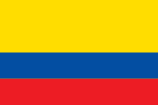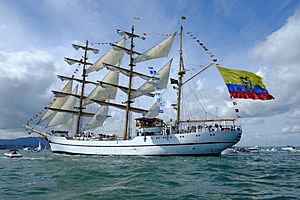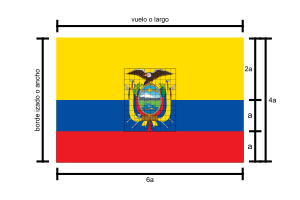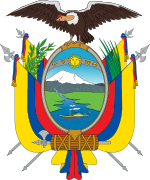Flag of Ecuador facts for kids
 |
|
| Name | La Tricolor (The Tricolor) |
|---|---|
| Use | State and war flag, state and naval ensign |
| Proportion | 2:3 |
| Adopted | 26 September 1860 (present ratio, November 2009) |
| Design | A horizontal tricolor of yellow (double width), blue and red with the National Coat of Arms superimposed at the center. |

Variant flag of Republic of Ecuador
|
|
| Use | Civil flag and ensign |
| Proportion | 2:3 |
| Design | A horizontal tricolor of yellow (double width), blue and red. |

The national flag of Ecuador has three horizontal stripes: yellow, blue, and red. It was first used in 1835 and officially adopted on September 26, 1860. In 1900, the country's coat of arms was added to the center of the flag.
Before this design, Ecuador used white and blue flags with stars, each star representing a province. The design of Ecuador's flag is very similar to the flags of Colombia and Venezuela. This is because all three countries were once part of a larger nation called Gran Colombia. Their flags are based on a design suggested by Venezuelan General Francisco de Miranda.
Ecuador's flag is one of only four national flags that show the flag itself within its design. The others are Haiti, the Dominican Republic, and El Salvador.
Contents
What the Flag Looks Like
In November 2009, Ecuador's National Secretariat of Communication set rules for the flag's design. This included its size and how the colors should be placed.
The national flag is 2.20 meters long and 1.47 meters wide. It has three horizontal colored stripes. The top yellow stripe is half the flag's width. The middle blue stripe and the bottom red stripe are each one-quarter of the flag's width. The Ecuadorian coat of arms is placed right in the middle of the flag.
The Coat of Arms
The coat of arms is inside an oval shield. In the background, you can see Chimborazo, the highest mountain in Ecuador. A river, the Guayas, flows from its base. Chimborazo is part of the Andes Mountains.
On the river, there is a steamboat also named Guayas. This ship was built in Guayaquil. It was the first steamship built in Ecuador and all of South America that could sail on the sea. It started working on October 9, 1841.
Above the shield, a golden sun is surrounded by four Zodiac signs: Aries, Taurus, Gemini, and Cancer. These signs represent the months from March to July. This period symbolizes the March Revolution of 1845. This revolution led to General Juan José Flores being removed from power.
A condor bird sits on top of the shield with its wings spread wide. This symbolizes Ecuador's power, greatness, and strength. It also means the country is always ready to defend itself. Four national flags stand on each side of the shield. On the left, a laurel branch represents the country's victories. On the right, a palm leaf honors those who died fighting for independence and freedom. Below the shield, a Fasces (a bundle of rods) stands for the country's dignity as a republic. The final design of the coat of arms was finished in 1900.
What the Colors Mean
Francisco de Miranda chose the colors for his flag based on Johann Wolfgang von Goethe's ideas about primary colors. In a letter from 1792, Miranda wrote about a conversation he had with Goethe in Germany. Goethe told him that his country's destiny was to create a place where primary colors were not changed.
Goethe explained that yellow is the warmest and noblest color, closest to bright light. Blue is a mix of excitement and calm, like shadows. Red is a combination of yellow and blue, showing how bright light can fade into shadows.
The yellow, blue, and red flag was first flown by Miranda in 1806. He used it on his ship Leander when trying to fight Spanish forces near Jacmel, Haiti. The colors of Ecuador's modern flag come from the flag of Gran Colombia. This nation included what is now Ecuador, Colombia, and Venezuela. The colors have these meanings:
- Yellow: Represents the country's crops and rich, fertile soil.
- Blue: Stands for the ocean and the clear skies above.
- Red: Symbolizes the blood shed by heroes who died fighting for their country's freedom.
Colors Used |
Yellow | Blue | Red |
|---|---|---|---|
| RGB | 255-221-0 | 3-78-162 | 237-28-36 |
| HEX | #ffdd00 | #034ea2 | #ed1c24 |
| CMYK | 0-13-100-0 | 98-52-0-36 | 0-88-85-7 |
Pledge and Song
Students and military cadets in Ecuador say a special promise to the flag. This is called the "Juramento a la Bandera," or "Pledge to the Flag." They usually do this on national holidays or at important school events, like graduations. There is also a patriotic song called the "Himno a la Bandera" ("Hymn to the Flag"). This song is often sung after the pledge or before ceremonies where old flags are retired.
How it Looks Like Other Flags
The flags of Ecuador, Colombia, and Venezuela all share a common history. They come from the flag of the nation of Gran Colombia (1819–1830). This short-lived republic included the lands of all three countries today. The Gran Colombian flag was inspired by the flag of the First Republic of Venezuela. This was the first independent government of Venezuela. General Francisco de Miranda created that flag, and it first flew in 1806 in Santa Ana de Coro, Venezuela.
Even today, the flags of Ecuador, Colombia, and Venezuela look similar. All three use the yellow, blue, and red stripes. However, there are some differences. In Colombia, a rule from 1934 set the stripe sizes at 2:1:1 (yellow is twice as wide as blue and red). The flag's overall shape is 2:3, like Ecuador's. Colombia's coat of arms is only added to the flag when used by government or military groups.
For Venezuela, the original design had all three stripes the same height. Since 1863, Venezuela decided to use white stars on its flag instead of a coat of arms. A coat of arms was added to Venezuela's national flag in 1954. It was changed again in 2006 to add another star and update the coat of arms. Also, the coat of arms on the Venezuelan flag is placed on the top left side, not in the center like Ecuador and Colombia.
See also
 In Spanish: Bandera de Ecuador para niños
In Spanish: Bandera de Ecuador para niños







